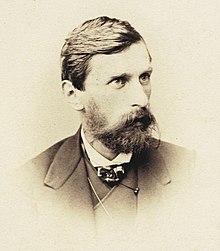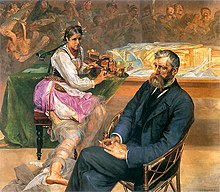Adam Asnyk
Adam Asnyk | |
|---|---|
 | |
| Born | 11 September 1838 Kalisz, Congress Poland |
| Died | 2 August 1897 (aged 58) Kraków, Austria-Hungary |
| Resting place | Skałka Church in Kraków |
| Occupation | Poet |
| Language | Polish |
| Literary movement | Positivism |
| Signature | |
Adam Asnyk (11 September 1838 – 2 August 1897), was a Polish poet and dramatist of the Positivist era.
Life and work
[edit]
Born in Kalisz to a szlachta family, he was educated to become an heir of his family's estate. As such he received education at the Institute of Agriculture and Forestry in Marymont and then the Medical Surgeon School in Warsaw. He continued his studies abroad in Breslau, Paris and Heidelberg. In 1862 he returned to Congress Poland and took part in the January Uprising against Russian rule. Because of that he had to flee his country and settled in Heidelberg, where in 1866 he received a doctorate of philosophy. Soon afterwards he returned to Poland and settled in the Austrian-held part of the country, initially in Lwów and then in Kraków.[1]
In 1875 Asnyk married Zofia née Kaczorowska, with whom he had a son, Włodzimierz, and around that time started his career as a journalist. An editor of a Kraków-based Reforma daily, in 1884 he was also chosen to the city council of Kraków. Five years later he was elected to the Diet of Galicia and Lodomeria.
Around that time he became one of the most prominent men of culture in partitioned Poland. Among his initiatives was the creation of the Society of Popular Schools and bringing the ashes of Adam Mickiewicz to Poland. He was also among the first members of the Tatra Society. He died on 2 August 1897 in Kraków and was buried at the Skałka church, a burial place for some of the most distinguished Poles, particularly those who lived in Kraków.[1]
Mastery of verse
[edit]Adam Asnyk was a master of verse. Some of his poems, for example Ulewa (The Heavy Rain) or Daremne żale (The Vain regrets), are among the best examples of iambic metre in all of Polish literature. He also used sophisticated strophes, for instance ottava rima. The poem Wśród przełomu[2] (At the breakthrough) is perhaps the first use of rhyme royal in original Polish poetry. His versification was often discussed by prominent Polish scholars, among others by Maria Dłuska and Lucylla Pszczołowska.[3]
Books of poetry
[edit]- Nad głębiami (Over the Depths) (1883–1894)
- Poezje (Poetries) (1869)
- Poezje (Poetries) (1872)
- Poezje (Poetries) (1880)
- Poezje (Poetries) (1894)
See also
[edit]References
[edit]- ^ a b Tomasz Mościcki. "Adam Asnyk". culture.pl (in Polish). Retrieved 20 March 2024.
- ^ Original Text
- ^ See also: Wiktor Jarosław Darasz, Mały przewodnik po wierszu polskim, Kraków 2003 (in Polish).
External links
[edit]- Polish Literature in English Translation: Adam Asnyk
- Works by Adam Asnyk at Project Gutenberg
- Works by or about Adam Asnyk at Internet Archive
- Adam Asnyk collected works (Polish)
- Works by Adam Asnyk at LibriVox (public domain audiobooks)

- 1838 births
- 1897 deaths
- People from Kalisz
- People from Kalisz Governorate
- 19th-century Polish nobility
- Members of Polish government (January Uprising)
- Members of the Diet of Galicia and Lodomeria
- People from Congress Poland
- Poets from the Russian Empire
- Poets from Austria-Hungary
- Polish male poets
- 19th-century Polish dramatists and playwrights
- 19th-century Polish writers
- 19th-century Polish poets
- University of Breslau alumni
- University of Paris alumni
- Heidelberg University alumni
- Congress Poland expatriates in France
- Congress Poland expatriates in Germany
- Polish positivists
